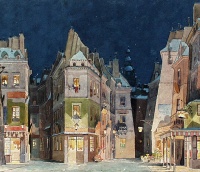Giacomo Puccini
From The Art and Popular Culture Encyclopedia

|
Related e |
|
Featured: |
Giacomo Antonio Domenico Michele Secondo Maria Puccini (December 22, 1858 – November 29, 1924) was an Italian composer whose operas, including La bohème, Tosca, and Madama Butterfly, are among the most frequently performed in the standard repertoire. Some of his melodies, such as "O mio babbino caro" from Gianni Schicchi and "Nessun dorma" from Turandot, have become part of modern culture.
Style
The subject of Puccini's style is one that has been long avoided by musicologists; this avoidance can perhaps be attributed to the perception that his work, with its emphasis on melody and evident popular appeal, lacked "seriousness" (a similar prejudice beset Rachmaninoff during his lifetime). Despite the place Puccini clearly occupies in the popular tradition of Verdi, his style of orchestration also shows the strong influence of Wagner, matching specific orchestral configurations and timbres to different dramatic moments. His operas contain an unparalleled manipulation of orchestral colors, with the orchestra often creating the scene’s atmosphere.
The structures of Puccini's works are also noteworthy. While it is to an extent possible to divide his operas into arias or numbers (like Verdi's), his scores generally present a very strong sense of continuous flow and connectivity, perhaps another sign of Wagner’s influence. Like Wagner, Puccini used leitmotifs to connote characters (or combinations of characters). This is apparent in Tosca, where the three chords which signal the beginning of the opera are used throughout to announce Scarpia. Several motifs are also linked to Mimi and the bohemians in La bohème and to Cio-Cio-San's eventual suicide in Butterfly. Unlike Wagner, though, Puccini's motifs are static: where Wagner's motifs develop into more complicated figures as the characters develop, Puccini's remain more or less identical throughout the opera (in this respect anticipating the themes of modern musical theatre).
Another distinctive quality in Puccini's works is the use of the voice in the style of speech: characters sing short phrases one after another as if they were talking to each other. Puccini is celebrated, on the other hand, for his melodic gift, and many of his melodies are both memorable and enduringly popular. These melodies are often made of sequences from the scale, a very distinctive example being Quando me'n vo' (Musetta's Waltz) from La bohème and E lucevan le stelle from Act III of Tosca. Today, it is rare not to find at least one Puccini aria included in an operatic singer's CD album or recital.
Pulitzer Prize-winning music critic Lloyd Schwartz summarized Puccini thus: "Is it possible for a work of art to seem both completely sincere in its intentions and at the same time counterfeit and manipulative? Puccini built a major career on these contradictions. But people care about him, even admire him, because he did it both so shamelessly and so skillfully. How can you complain about a composer whose music is so relentlessly memorable, even — maybe especially — at its most saccharine?"

